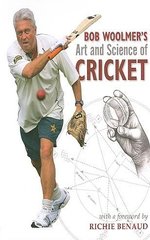Bob Woolmer’s Art and Science of Cricket
Stuart Wark |Published: 2008
Pages: 650
Author: Woolmer, Bob
Publisher: New Holland Publishers
Rating: 4.5 stars

Trying to determine whether a piece of art or music will stand the test of time is a fun exercise, but also an exceptionally difficult one. Every year, radio stations and video hits channels hold contests for listeners to vote on the greatest song in history. And, inevitably, whatever song is currently near the top of the charts will also rate in the top 10 of all-time. However, in just twelve months time, that same song will often be languishing well behind “Shuddup Ya Face”, “Cotton Eye Joe” and “Wake Me Up Before You Go Go”.
The same principle applies to literature, with reviewers often passionately endorsing a new release and then quickly forgetting it soon afterwards. Cricket books are no different, and as such, the review team sometimes make a decision to sit on a book for a while, so that the final rating is not unduly affected by external factors. This was the case with the posthumous publishing of Bob Woolmer’s The Art and Science of Cricket. However, a couple of years after the initial 2008 release, it was felt appropriate to now provide a review.
There have been many cricket coaching manuals over the years. Some of the better known ones include James Pycroft’s 1851 book entitled The Cricket Field (or The History and the Science of Cricket), The Jubilee Book of Cricket by Ranjitsinhji (1897), Bradman’s 1958 classic The Art of Cricket (see Swaranjeet Singh’s review here ), Cricket Skills by Frank Tyson (1985), as well as a myriad of “How I Play Cricket” type titles over the years by every man and his pet dog. In order to differentiate the book from these previous options, Woolmer, in conjunction with his co-authors Tim Noakes and Helen Moffett, took a very scientific and modern approach to not just on-the-field technical and strategic issues, but also some more esoteric factors including fitness, psychology, physiology and, most importantly, how to sledge effectively.
Woolmer provides a wonderful examination of many established principles of the game, and re-evaluates whether they are truly important or not. While he provides a good description of the basics, such as how to bowl an in-swinger or play a cut shot, he also covers such diverse areas as what is the best stump to take guard on as a batsman, the physics of reverse swing, the affect of colour blindness, how much advantage you can gain by ‘chucking’ compared to bowling the ball, the impact of alcohol on your body, and much more. It is truly an in-depth review of how to play the game in the modern era. This is not a coaching manual for either the very young or the casual fan. It is close on 700 pages, and provides a lot of detail for keen followers of the game. However, it is not particularly difficult to read, as it is presented in small sections that assist in breaking up the content into manageable bites. It is far more comprehensive than Woolmer’s other work, Bob Woolmer on Batting, Bob Woolmer on Bowling.
It is noted that this book was ten years in the making, and that Woolmer was still working on it at the time of his death before it was finally completed by Noakes. The fact it was not completed by Woolmer is clear at times. There is an undercurrent that Woolmer is not entirely objective in his assessments of the players he coached. A number of descriptive errors are also evident, which I am sure that Woolmer would have spotted during a final editing process. While I accept that Brian Close was a very handy bowler, to categorise him as a ‘tailender’ is not particularly flattering. Particularly when it was used in the context of a Test match in which he actually opened the batting in both innings. Another example includes a description of Sarfraz Narwaz as a speed merchant of the same ilk as Dennis Lillee, Jeff Thomson and John Snow. These are but minor problems in the scheme of things, however, they are slightly off-putting in a book proclaiming to be the definitive text.
Following its release in 2008, most reviews of The Art and Science of Cricket were particularly complementary, and predicted it to immediately assume the place as the pre-eminent coaching book. Three years down the track, it is possible to ask whether these sentiments were accurate. It would be easy to argue that many of the early reviews were overly sympathetic, considering the tragic death of Woolmer prior to its publication. However, this would be to downplay the value of this book. Part of its great charm is the fact that it is willing to not just present the standard ideas, but completely stand many of them on their head in order to see what happens.
It is not perfect, but it is certainly the best modern coaching book available. Will it stand the test of time? Yes. 4.5 stars.






Best book on cricket
Comment by Athar | 5:20am GMT 21 November 2021